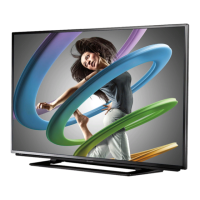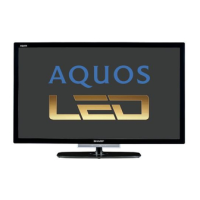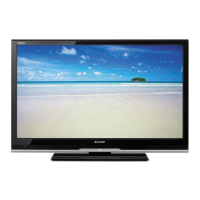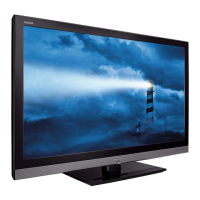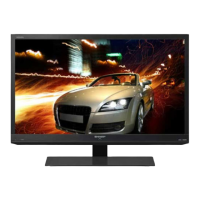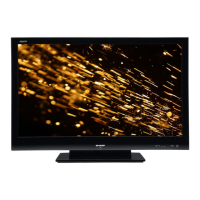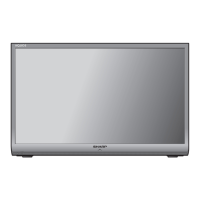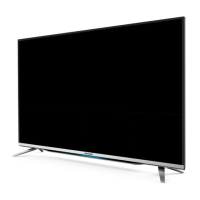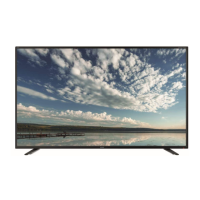How do I reset my Sharp LC-32LB370U password?
- BBrittany OneillSep 12, 2025
If you have lost the password for your Sharp TV, enter 9999 to access parental controls, then set a new password.
How do I reset my Sharp LC-32LB370U password?
If you have lost the password for your Sharp TV, enter 9999 to access parental controls, then set a new password.
Why is my Sharp LC-32LB370U TV not displaying video from the connected CEC device?
If your Sharp TV is not displaying video from the connected CEC device, ensure the HDMI cable is securely connected to both the TV and the device. Verify the device is CEC-compatible by checking its documentation. Select the correct video input source. Ensure the CEC Control feature is turned on. Try adjusting the TV picture.
Why does my Sharp LC-32LB370U have good sound but poor color?
If your Sharp TV has good sound but poor color, adjust the contrast, color, and brightness settings.
Why does my Sharp LC-32LB370U TV remote control not work?
If the Sharp TV remote control isn't working, ensure the power cord is properly connected to both the TV and the power outlet. Check for any obstructions between the remote and the sensor on the TV's front. Point the remote directly at the sensor. Remove any plastic wrapping from the batteries, ensure they're installed correctly, or replace them with new ones.
Why does my Sharp LC-32LB370U only show snow?
If only snow (noise) appears on the screen of your Sharp TV, try another channel as the station may be experiencing problems. Ensure that the antenna or cable TV is connected correctly and securely. If you are using an antenna, the digital channel signal may be low. To check the digital channel signal strength, see “Checking the digital signal strength” on page 52. If you are using an antenna and the signal strength is low, adjust the antenna or use a highly directional outdoor antenna or set-top antenna with a built-in amplifier.
Why is there no color on my Sharp TV?
If your Sharp TV has no color, a dark picture, or the color is incorrect, try another channel as the station may be experiencing problems. Adjust the color settings and ensure the video cables are connected correctly and securely to your TV. Also, make sure the antenna or cable TV is connected correctly and securely. If using an antenna, the digital channel signal may be low, so check the signal strength and adjust the antenna or use a directional outdoor antenna with an amplifier if needed.
Why is the picture dark on my Sharp TV but the sound is good?
If your Sharp TV displays a dark, poor, or no picture, but the sound is good, try another channel as the station may be experiencing problems. Ensure the antenna or cable TV is correctly and securely connected. Adjust the brightness and make sure the correct picture mode is selected. If using an antenna, the digital channel signal may be low, so check the signal strength. Adjust the antenna or use a directional outdoor antenna with an amplifier if needed. Make sure the video cables are securely connected, and try a new set of video cables in case the current ones are faulty.
Why is the picture quality on my Sharp LC-32LB370U good on some channels and poor on others?
If your Sharp TV picture quality is good on some channels but poor on others, it may be due to a weak signal from the broadcaster or cable TV provider. If you connect to cable or satellite TV without a set-top box, consider installing one to improve signal reception and picture quality. Contact your provider for details on upgrading to a set-top box.
How to fix black bars on Sharp LC-32LB370U?
If the picture on your Sharp TV does not fill the screen and there are black bars around it, change the aspect ratio. Digital TV and movies are often presented in widescreen (16:9). Refer to the View Mode option in the “Adjusting the TV picture” section on page 44.
Why does my Sharp LC-32LB370U TV have no power?
If your Sharp TV has no power, ensure the power cord is properly connected to both the TV and the power outlet. Try unplugging the power cord, waiting 60 seconds, and then plugging it back in and turning on the TV. Also, other devices may be interfering with your TV, so try turning them off one at a time to identify the source of interference and move it further away from the TV.
| Comb filter | 3D |
|---|---|
| Screen shape | Flat |
| Response time | - ms |
| Display diagonal | 31.5 \ |
| Display brightness | - cd/m² |
| LED backlighting type | Direct-LED |
| Supported video modes | 1080p |
| Contrast ratio (dynamic) | 2000000:1 |
| Screen format adjustments | 16:9 |
| Supported graphics resolutions | 1920 x 1080 (HD 1080) |
| Motion interpolation technology | - |
| 3D type | Active |
| Tuner type | Analog & digital |
| Number of tuners | 2 tuner(s) |
| Analog signal format system | NTSC |
| Digital signal format system | ATSC |
| Audio system | DTS Sound |
| Audio decoders | DTS |
| RMS rated power | 5 W |
| Number of speakers | 2 |
| HDMI ports quantity | 3 |
| DVI-D ports quantity | 0 |
| USB 2.0 ports quantity | 1 |
| Consumer Electronics Control (CEC) | Aquos Link |
| On Screen Display (OSD) languages | ENG, ESP, FRE |
| Product color | Black |
| Panel mounting interface | 100 x 100 mm |
| AC input voltage | 120 V |
| AC input frequency | 60 Hz |
| Power consumption (standby) | 1 W |
| Power consumption (typical) | 47 W |
| Depth (with stand) | 184 mm |
|---|---|
| Height (with stand) | 464 mm |
| Weight (with stand) | 5100 g |
| Depth (without stand) | 64 mm |
| Width (without stand) | 727 mm |
| Height (without stand) | 437 mm |
| Weight (without stand) | 4900 g |
Guidelines for safe TV placement and handling to prevent injury.
Covers warnings about water, heat, ventilation, and electrical hazards.
Instructions for proper cord protection, attachments, and handling.
Includes servicing, grounding, condensation, and mobile phone warnings.
Details on power source, servicing instructions, and damage requiring service.
Guidance on outdoor antenna grounding, CATV installation, and condensation.
Covers mobile phone warnings, end-of-life disposal, and non-active pixels.
Cautions regarding wall-mount bracket installation and safety.
Details on mounting hole dimensions and screw types for wall mounting.
Step-by-step guide for attaching the TV stand.
Important notes regarding stand installation and storage.
Describes the function and connection for HDMI 3, HDMI 2, and HDMI 1/ARC ports.
Explains the use of the USB port for flash drives and picture files.
Details the /AUDIO OUT and DIGITAL AUDIO OUTPUT ports.
Explains the ANT/CABLE jack and Y/VIDEO, PB/PR, L/R audio jacks.
Identifies and explains the function of each button on the remote.
Provides important cautions and notes for using the remote.
Lists all items included in the TV package.
Explains the function of the buttons located on the front of the TV.
Step-by-step guide for connecting to a cable/satellite box using HDMI.
Instructions for connecting devices using component video cables.
Steps for connecting devices using AV composite video cables.
Guide for connecting to TV using a coaxial cable.
Instructions for connecting antenna or cable TV directly to the TV.
Steps to connect DVD or Blu-ray players using HDMI.
Instructions for connecting players using component video cables.
Steps for connecting players using AV composite video cables.
Guide for connecting game consoles using HDMI.
Instructions for connecting game consoles using component video.
Steps for connecting game consoles using AV composite video.
Guide for connecting computers using HDMI.
Steps for connecting and using a USB flash drive for photos.
Instructions for connecting headphones to the audio out jack.
Steps for connecting speakers/sound bars via digital audio.
Instructions for connecting speakers/sound bars via analog audio.
Diagram showing connections for a multi-device home theater system.
Steps to connect the AC power cord to the TV and power outlet.
Guide on how to insert batteries into the remote control.
Advice on pointing the remote control towards the TV sensor.
Instructions for programming universal remote controls for the TV.
How to access and view universal remote control codes on the TV.
Steps for turning on the TV and starting the initial setup wizard.
Guide to customizing settings like region, language, and time during setup.
Steps for setting up channels, including cable, antenna, or none.
How to label connected devices for easier input selection.
Overview of how to navigate through the TV's on-screen menus.
Explains the Picture and Sound menu options.
Explains how to use remote buttons to navigate menus.
Shows how to access Channels, Settings, and Photos menus.
How to select channels, view information, and adjust volume.
Explains how to use HDMI CEC for device control.
Steps to turn the main CEC Control feature on or off.
How to configure Device Auto Power Off and TV Auto Power On.
How to turn the Audio Return Channel feature on or off.
How to view a list of connected CEC-compatible devices.
Steps to select a CEC-compatible device from a list.
How to open the root menu of a CEC-compatible device.
How to switch to USB mode and browse photo files.
How to browse and view favorite photos from a USB drive.
Steps to start and control a photo slideshow from USB.
Explains settings like Backlight, Brightness, Contrast, and Color.
Details on advanced settings like Tint, Sharpness, and custom picture modes.
Explains various aspect ratio options like Normal, Zoom, Wide, and Cinema.
How to use the Auto View Mode for automatic aspect ratio adjustment.
How to select different sound modes like Standard, Movie, and Music.
Explains features like Voice, Balance, Bass, and Treble.
How to select audio output modes like Headphones, Analog TV, and Surround Sound.
Steps to perform an automatic scan for available channels.
How to hide channels from the channel list to skip them.
How to create and manage a list of favorite channels.
How to access and select channels from the favorite list.
Steps to add or change labels for TV channels.
How to check the digital signal strength for optimal picture quality.
Guide to setting up parental controls and passwords.
How to block TV programs that do not have a rating.
Steps for changing the parental control password.
How to set parental control levels based on US and Canadian ratings.
How to configure V-Chip ratings for US and Canadian content.
How to lock the physical buttons on the TV using the remote.
How to select analog closed captioning modes (CC1-CC4).
How to select digital closed captioning modes.
How to customize digital closed captioning style, font, and colors.
Steps to set the current time and date on the TV.
How to set the sleep timer to automatically turn off the TV.
How to change the TV's menu language.
How to turn the Input Sensor on or off for auto input detection.
How to label connected input sources for easier identification.
Instructions for cleaning the TV cabinet and screen.
How to access and view the TV's system information.
Guidance on where to find more information for troubleshooting.
Steps to update the TV's firmware using a USB flash drive.
How to reset all TV settings to their factory defaults.
Solutions for common picture problems like no screen display or poor quality.
Solutions for common audio problems like no sound or poor sound quality.
Solutions for screen issues like dots, lines, or double images.
Troubleshooting for sound issues and audio cable connections.
Solutions for problems where the remote control is not functioning.
Common issues like no channels or error messages.
Troubleshooting steps when a CEC device does not appear on the TV.
Solutions for issues with CEC devices not turning on or off with the TV.
How to manage the Audio Return Channel CEC setting.
What to do if a device is not supported by the CEC feature.
Detailed dimensions and weight of the TV with and without stand.
Information on display type, resolution, refresh rate, and aspect ratio.
Details on power consumption, input type, and power requirements.
Includes specs for Wi-Fi, Internet, OSD languages, and VESA mounts.
Legal compliance information regarding FCC rules and radio frequency.
Information on Dolby Digital, DTS, and HDMI licensing.
Details about open source software used in the product.
Details of the limited warranty coverage for Sharp Televisions.
List of conditions and situations not covered by the warranty.
Instructions on how to get warranty service and contact support.
